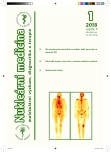Vascular malformation of the face detected on a bone scan
Authors:
Viera Rousková 1; Otto Lang 2
Authors‘ workplace:
Oddělení nukleární medicíny, ON Trutnov a. s., ČR
1; Oddělení nukleární medicíny, ON Příbram a. s., ČR
2
Published in:
NuklMed 2018;7:14-15
Category:
Overview
67-y-old lady was sent to our department for a bone scan due to a fall to the left knee because of a vertigo. She had a hypertension and a post-traumatic epileptic syndrome stabilized with an appropriate therapy. Total thyreoidectomy was performed years ago due to a papillary thyroid carcinoma, follow-up examinations were always negative. Also hysterectomy and cholecystectomy were done years ago as well as total knee prosthesis due to a serious arthrosis.
Bone scan was performed as a two-phase examination with an early imaging of a blood pool distribution after 15 minutes post injection of 940 MBq of 99mTc-HDP (patient weight was 94 kg) with a dual-head SPECT gamma camera BrightView XCT. This scan revealed expected increased blood-pool in the region of the left knee after falling but moreover there was also increased radiopharmaceutical accumulation in the region of her right face. (Fig. 1) On the late scan performed after 3 hours post injection, physiological distribution of the bone metabolic turnover corresponding to her age was detected with increased one in the region of the left knee, the right face was without any pathology. (Fig. 2). Careful clinical examination proved a slight bluish shine of a vascular malformation at this location; it was confirmed by the patient after a targeted question. She was diagnosed with a venous or capillary-venous malformation localized in the right side of her face laterally to a mandible of the size of 9 x 4.5 cm with an intracranial propagation to the temporo-basal area using angiography and magnetic resonance imaging years ago.
Key Words:
vascular malformation, bone scan
Sources
1. Gandsman EJ, Deutsch SD, Tyson IB. Atlas of Computerized Blood Flow Analysis in Bone Disease. Clin Nucl Med 1983;8:558-563
2. Shafer RB, Edeburn GF. Cant he Three-phase Bone Scan Differentiate Osteomyelitis from Metabolic or Metastatic Bone Disease? Clin Nucl Med 1984;9:373-377
3. Thakore KJ, Hudson TM, Monson DK et al. Triple-phase Bone Scan Findings in Aggresive Fibromatosis Before and After Radiation Therapy. Clin Nucl Med 1994;19:197-203
4. McCarthy. Histopathologic Correlates of a Positive Bone Scan. Semin Nucl Med 1997;27:309-320
5. Štufková I, Lang O. Scintigrafické zobrazení hemangiomu – kazuistika. NuklMed 2016;5:10-14
6. Webster DL, Hurwitz GA, DeVeber LL et al. Increased Activity on Immediate Phase of Bone Imaging Does Not Always Indicate Increased Blood Volume. Clin Nucl Med 1986;11:749-750
7. Kozák Š, Lang O. Obraz chordomu sakrální oblasti na třífázové scintigrafii skeletu a při scintigrafickém vyšetření značenými leukocyty. NuklMed 2017;6:32-35
Labels
Paediatric radiology Nuclear medicine Clinical oncology Radiodiagnostics RadiotherapyArticle was published in
Nuclear Medicine

2018 Issue 1
Most read in this issue
- Targeted alpha therapy and its role in a modern nuclear medicine
- Influence of a department monitoring to the staff radiation exposure at a PET department
- Vascular malformation of the face detected on a bone scan
